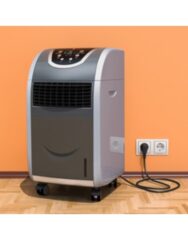Not sure which AC to choose? This AC Buying Guide in India breaks down top models, features, and expert recommendations for all needs.

AC Buying Guide in India 2023: Nowadays, with the availability of multiple brands, choosing the right air conditioner becomes confusing and puzzling. To buy the best brand of AC, you need to know the selection criteria.
Type of AC
Window Air Conditioners
A window air conditioner is a compact unit that cools only one room and is installed in the window of a room.
Window AC recycles the air inside the room from the front side and blows out hot air from the back. These types of units are best for those who live in small spaces. It is ideal for a larger home, as you will discover that it does not cool efficiently in that kind of environment.
Split Air Conditioners
Ductless, mini-split systems are the most common types of Air Conditioning. Like central AC, these systems also have an outdoor compressor unit and an indoor blower.
If you are looking to cool individual rooms in your house, these systems might be just for you. Many ductless, mini-split systems can have as many as four indoor handling units. All these are connected to one outdoor unit.
Portable Air Conditioners

Portable air conditioners are the next generation of air conditioning systems. It recycles air within the room and vents hot air outside through an exhaust hose installed in a window.
Like window air conditioners, portable air conditioning cools only one room. They are easy to install, versatile, and affordable. You will find keeping your AC cool on a hot summer day much easier.
READ ALSO: How to reduce your AC power consumption on your home AC
Central Air Conditioners
Of all the different types of AC, Central Air Conditioning is the most common type of cooling system. It is ideal for larger rooms due to its cooling power.
Central air conditioning circulates air through supply and return ducts. The supply duct, which travels inside the ceiling, carries cooled air into the room. The room air goes back into the AC through the return duct.
Installing a central AC needs a lot of planning, designing, and execution. If you install a system that is of the wrong size, replacing it will be costly.
Hybrid Air Conditioners
Hybrid Air Conditioning definition
“The use of two or more technologies to achieve a common goal resulting in a reduction to the total energy used.”
They are
- Solar power hybrid AC: AC runs on solar panels
- Using waste energy: Here, the AC runs on Gober gas
- Reverse cycle mechanism: hot and Cold AC
Geothermal Heating and Cooling
Geothermal technology uses the Earth’s heat. Some feet beneath the surface, the Earth maintains a near-constant temperature, in contrast to the summer and winter extremes of the ambient air above ground.
Further below the earth’s surface, the temperature drops at a rate of 1°F for every 70 feet of depth.
In certain areas, tectonic and volcanic activity can bring higher temperatures and pockets of superheated water and steam much closer to the surface.
The heat pump works in “heating mode,” – takes heat from the ground and delivers it to a building, and “cooling mode,” – which removes heat from the building and transfers it to the ground.
Capacity of AC
If you buy a low tonnage AC, power consumption will be high.
Lower tonnage AC may save on your first time capital cost but not on power consumption. The lifespan of the appliance will also decrease.
There are two factors you need to keep in mind before buying the best split AC under 30,000 INR.
- If you live in areas where temperatures cross over 45 degrees Celsius, you need to consider adding an additional 0.5 tons.
- Additionally, if you stay on the top floor of your building, it is advisable to have a higher tonnage.
Compressor type: Inverter Vs non-inverter
Inverter Compressor Overview
The DC Inverter compressor has a variable frequency drive to control the speed of the compressor and the cooling output.
This drive converts the incoming AC to DC and then, through modulation, produces a current of a desired frequency. The temperature sensor collects data of ambient temperature and adjusts the speed of the compressor to provide the required cooling.
Non Inverter Compressor Overview
Non-inverter compressors are even referred to as rotary or hermetic reciprocating. Such a type of compressor keeps running at full speed until the thermostat cuts it down.
Once the set temperature is reached, the compressor will cut off and restart with a differential of 2.5 degrees Celsius.
Which compressor is better, an inverter or a non-inverter?
Let us know first benefits of Inverter compressors
- Eco friendly
- Saves power by 30%
- It is more silent than rotary & hermetic
- The life span is higher
- Maintains uniform room temperature
- It is more silent
Now it is clear that an inverter compressor is better in comparison to a non-inverter.
Energy Efficiency ratings
EER: Energy efficiency ratings
In 2016, the Bureau of Energy Efficiency (BEE) came up with a new rating methodology called “ISEER (Indian Seasonal Energy Efficiency Ratio) Ratings.”.
This rating is more reliable as compared to other conventional methods for buying the best AC brand. Buyers can now plan their power consumption as per their star rating. The higher the star rating grade, the lower the power consumption, and vice versa.
For example,
For home use, where your AC is used for 2-3 hours a day, a 3-star rating is perfect, 5 star rating is a better choice for heavy users.
Corporate customers can always buy a 5-star AC, as usage is high.
Types of refrigerants
What is refrigerant?
For buying the best air conditioners in India, you need to consider the gas used in the AC. Gases are used as fuel to cool the room. The phase-out gas is F-22, which is being replaced by 410A.
With the availability of new advanced technology, AC has used the new 410A gas for technical reasons. Another key reason for the replacement of gas is the star rating.
What to do when Your Refrigerant Type Is banned
If F-22 gas is banned, you need not fear. The gas could be available for some time until it is in stock.
On the flip side, if you decide to upgrade your existing AC, you will enjoy power efficiency and reliability.
Also, you could take advantage of the extra cooling of 410A gas, which could provide strength over the long run.
Making the right refrigerant choice is better for the environment and efficiency.
Features to look for while buying
- Additional Features to Consider While Buying an AC
- Auto Start
- Dehumidification
- Four-Way Swing
- Sleep Timer
- Smart Features, App Control, and Wi-Fi Connectivity
- Turbo Mode
Is it worth it to buy a portable air conditioner?
Best Air Conditioner Brands Available in India
The Indian marketplace for home electronics features many large air conditioner brands, including Carrier, Diakin, and Voltas, to name just a few.
The world of split Air Conditioners has seen significant technological upgrades, like inverter technology. Such new technology improves room cooling, humidity, temperature, and air purification.
These provide full satisfaction and comfort for the health of loved ones within the room.
Within the price range of Rs. 30000, a user could find 200 split air conditioners with a capacity varying from 0.80 to 1.5 tons. Few popular brands.
- Carrier
- Diakin
- Voltas
- Blue Star
- Hitachi
- Godrej
- Panasonic
- L.G
READ MORE: Know 5 common AC myths that must stay far this summer to save power & money
Conclusion: AC buying guide in India 2023
Buying an Air Conditioner is a high investment. After all, it is the best AC that keeps your family comfortable.
We have provided all the inputs in this AC buying guide on how to buy the best AC. We have covered topics like star rating, power saving techniques, brand selection, compressor selection, gas, and much more.
This information is in the AC buying guide in India to buy the best split AC under 30000. However, you can also use our buyers’ guide to buy the best split AC under 40000 or 50000. This knowledge will be enough to help you make the right decision to buying the best AC for your home.
If you have any queries post them on the contact page and we will answer them.


